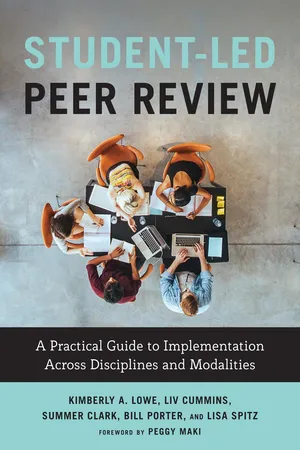
Student-Led Peer Review
A Practical Guide to Implementation Across Disciplines and Modalities
- 156 pages
- English
- ePUB (mobile friendly)
- Available on iOS & Android
Student-Led Peer Review
A Practical Guide to Implementation Across Disciplines and Modalities
About this book
Student-led peer review can be a powerful learning experience for both giver and receiver, developing evaluative judgment, critical thinking, and collaborative skills that are highly transferable across disciplines and professions. Its success depends on purposeful planning and scaffolding to promote student ownership of the process. With intentional and consistent implementation, peer review can engage students in course content and promote deep learning, while also increasing the efficiency and effectiveness of faculty assessment.
Based on the authors' extensive experience and research, this book provides a practical introduction to the key principles, steps, and strategies to implement student peer review – sometimes referred to as "peer critique" or "workshopping." It addresses common challenges that faculty and students encounter. The authors offer an easy-to-follow and rigorously tested three-part protocol to use before, during, and after a peer review session, and advice on adapting each step to individual courses.
The process is applicable across all disciplines, content types, and modalities, face-to-face and online, synchronous and asynchronous. Instructors can guide students in peer review in one course, across two or more courses that are team-taught, or across programs or curriculums. When instructors, students, and university stakeholders create a culture of peer review, it enhances learning benefits for students and allows faculty to share pedagogical resources.
This book is intended as a practical guide for instructors to use in their classrooms but can equally be used in the context of faculty learning communities, departmental workshops, or in a faculty development context to promote consistent and wide usage on campus. Student peer review is a high-impact pedagogy that's easily implemented, inculcates lifelong learning skills in students, and relieves the assessment burden on faculty as students collaborate to improve their own work and develop into self-regulated learners.
Frequently asked questions
- Essential is ideal for learners and professionals who enjoy exploring a wide range of subjects. Access the Essential Library with 800,000+ trusted titles and best-sellers across business, personal growth, and the humanities. Includes unlimited reading time and Standard Read Aloud voice.
- Complete: Perfect for advanced learners and researchers needing full, unrestricted access. Unlock 1.4M+ books across hundreds of subjects, including academic and specialized titles. The Complete Plan also includes advanced features like Premium Read Aloud and Research Assistant.
Please note we cannot support devices running on iOS 13 and Android 7 or earlier. Learn more about using the app.
Information
Table of contents
- Cover
- Half-title Page
- Title Page
- Copyright
- Contents
- Foreword
- Acknowledgments
- Introduction: When I Hear Peer Review, I Think . . .
- 1 Research on Peer Review: Benefits, Challenges, and Best Practices
- 2 Pre-Peer Review: Preparing Students to Engage in Peer Review
- 3 Peer Review: Facilitating Students to Exchange Feedback
- 4 Post-Peer Review: Guiding Students to Use Feedback
- 5 Incorporating the Three-Part Protocol into Your Course
- 6 Fostering a Shared Culture of Peer Review Beyond Your Course
- Appendix A: Three-Part Protocol for Effective Peer Review
- Appendix B: Peer Review Session Case Studies
- Appendix C: Guide to Peer Review Tools
- References
- About the Authors
- Index
- Also available from Stylus
- Backcover